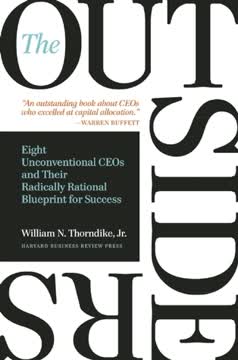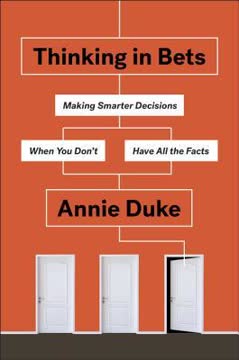Key Takeaways
1. Successful investing is about execution, not prediction
Success in investing is down to how great ideas are executed.
Execution trumps prediction. The author's research on top investors revealed that even the best were only right about 49% of the time. Yet, they still managed to make substantial profits. This counterintuitive finding underscores that success in investing isn't about having a crystal ball, but rather about how you handle your investments after making them.
Key aspects of good execution:
- Having a clear plan before investing
- Knowing when to cut losses
- Understanding when to add to winning positions
- Managing position sizes effectively
- Maintaining discipline in both winning and losing scenarios
The ability to execute well can turn even mediocre ideas into profitable investments, while poor execution can squander even the most brilliant insights. This principle levels the playing field, suggesting that retail investors can compete with professionals by focusing on execution rather than trying to out-predict the market.
2. The Rabbits: Learn from their mistakes and avoid inaction
Doing nothing when you are losing is never an option because if the stock price rises from here you should have put more money to work. If it falls further you should have cut your position.
Inaction leads to capital impairment. The Rabbits, a group of investors identified by the author, demonstrated the perils of doing nothing when faced with losing positions. Their tendency to freeze and hope for recovery often led to substantial losses.
Common Rabbit mistakes:
- Falling victim to sunk cost fallacy
- Allowing emotions to override rational decision-making
- Failing to have a pre-determined plan for losses
- Succumbing to confirmation bias
To avoid becoming a Rabbit, investors should:
- Develop a clear exit strategy before investing
- Regularly reassess investments as if starting from scratch
- Be willing to admit mistakes and take action
- Use stop-loss orders to automate difficult decisions
By learning from the Rabbits' mistakes, investors can protect their capital and improve their overall performance.
3. The Assassins: Master the art of cutting losses quickly
The Assassins were some of the most disciplined investors I have met, and a significant factor in their ability to make money was that they cut their losses consistently.
Swift loss-cutting preserves capital. The Assassins, another investor group identified by the author, excelled at quickly cutting their losses. This approach allowed them to preserve capital and redeploy it into more promising opportunities.
Key Assassin strategies:
- Setting predetermined stop-loss levels (typically 20-33%)
- Using time-based stops to avoid prolonged underperformance
- Emotionally detaching from losing positions
- Focusing on overall portfolio performance rather than individual trades
The Assassins' approach aligns with Warren Buffett's famous rules: "Rule No. 1: Never lose money. Rule No. 2: Never forget rule No. 1." By consistently limiting losses, investors can significantly improve their long-term returns and reduce the impact of inevitable mistakes.
4. The Hunters: Turn losses into wins by buying more strategically
The Hunters turned a loser into a winner.
Strategic averaging down can be powerful. The Hunters demonstrated the potential of turning losing positions into winners by strategically adding to their positions as prices fell. This approach, when executed correctly, can significantly enhance returns.
Hunter tactics:
- Maintaining conviction in the original investment thesis
- Allocating capital in tranches rather than all at once
- Using market downturns as opportunities to lower average cost
- Remaining patient and disciplined in the face of short-term volatility
Key to the Hunters' success was their ability to:
- Distinguish between temporary price declines and fundamental changes
- Maintain emotional control during drawdowns
- Have a long-term perspective on their investments
While this strategy can be highly effective, it requires careful analysis and risk management to avoid throwing good money after bad. Investors should only consider this approach for high-conviction ideas with strong long-term prospects.
5. The Raiders: Avoid premature profit-taking and missed opportunities
Selling a winner can seriously damage your wealth.
Resist the urge to sell too soon. The Raiders, characterized by their tendency to take quick profits, often missed out on substantial gains by selling winning positions prematurely. This behavior can significantly limit long-term returns.
Reasons investors become Raiders:
- Fear of losing paper profits
- Overconfidence in ability to time the market
- Short-term focus and impatience
- Misunderstanding of compounding effects
To avoid the Raider pitfall:
- Focus on long-term potential rather than short-term gains
- Understand the power of compound growth
- Develop a strategy for partial profit-taking to satisfy the urge to realize gains
- Regularly reassess the investment thesis rather than relying on price movements alone
By resisting the temptation to raid profits too quickly, investors can allow their winners to run and potentially achieve outsized returns.
6. The Connoisseurs: Maximize returns by riding big winners
Big winners are rare and I am yet to see a successful investor who has not 'hung around' with big winners.
Let your winners run. The Connoisseurs exemplified the power of staying invested in big winners. Their ability to identify and hold onto high-performing stocks for extended periods was key to their outsized returns.
Connoisseur characteristics:
- High tolerance for paper gains and volatility
- Focus on long-term business fundamentals
- Willingness to maintain large positions in high-conviction ideas
- Regular trimming of positions to manage risk while maintaining exposure
Strategies for becoming a Connoisseur:
- Develop a deep understanding of businesses and their long-term potential
- Cultivate patience and resist the urge to trade frequently
- Use partial selling to satisfy the desire to take profits without exiting completely
- Regularly reassess the investment thesis to ensure it remains valid
The Connoisseur approach aligns with the investing styles of many successful investors and can lead to superior long-term performance.
7. Concentrate on your best ideas for superior performance
What if each mutual fund manager had only to pick a few stocks, their best ideas? Could they outperform under those circumstances? We document strong evidence that they could, as the best ideas of active managers generate up to an order of magnitude more alpha than their portfolio as a whole.
Focus breeds outperformance. Research shows that professional fund managers' top ideas significantly outperform their overall portfolios. This suggests that concentrating on one's best ideas can lead to superior returns.
Benefits of concentration:
- Allows for deeper analysis and understanding of fewer companies
- Reduces the impact of mediocre ideas on overall performance
- Aligns with the strategies of many successful investors like Warren Buffett
Challenges of concentrated investing:
- Requires high conviction and emotional discipline
- Can lead to higher short-term volatility
- May conflict with traditional notions of diversification
For individual investors, focusing on a smaller number of high-conviction ideas can be a path to outperformance. However, this approach requires thorough research, ongoing monitoring, and the ability to withstand periods of underperformance.
8. Overcome psychological barriers to successful investing
The best performers force deadlines on themselves.
Master your emotions. Many of the psychological barriers to successful investing stem from innate human biases and emotions. Overcoming these obstacles is crucial for long-term success.
Common psychological barriers:
- Loss aversion: The tendency to feel losses more acutely than gains
- Confirmation bias: Seeking information that confirms existing beliefs
- Recency bias: Overweighting recent events in decision-making
- Overconfidence: Overestimating one's own abilities
Strategies to overcome these barriers:
- Develop and stick to a systematic investment process
- Use rules-based approaches to remove emotion from decisions
- Regularly challenge your own assumptions and seek contrary opinions
- Study behavioral finance to understand and counteract common biases
By recognizing and actively working to overcome psychological barriers, investors can make more rational decisions and improve their long-term performance.
9. Adapt your strategy when losing and stay disciplined when winning
If you can't convince yourself when I'm down 25% I'm a buyer then you'll never make a decent profit in stocks.
Flexibility in losses, discipline in gains. Successful investing often requires different approaches when facing losses versus managing gains. Adapting to losing positions while maintaining discipline with winners is a hallmark of top investors.
When losing:
- Reassess the investment thesis objectively
- Be willing to cut losses or average down based on careful analysis
- Avoid the temptation to do nothing out of fear or hope
When winning:
- Resist the urge to sell simply because of price appreciation
- Regularly review the investment case to ensure it remains valid
- Consider trimming positions to manage risk while maintaining exposure
By combining adaptability in the face of losses with discipline when managing gains, investors can improve their overall returns and reduce the impact of inevitable mistakes.
10. Learn from the world's top investors, but forge your own path
I have come to understand that if successful property investing is all about 'location, location, location', success in equity investing is all about 'execution, execution, execution'.
Synthesize wisdom, develop your style. While studying successful investors provides valuable insights, it's crucial to develop an approach that suits your own personality, risk tolerance, and goals.
Key lessons from top investors:
- Focus on execution rather than prediction
- Develop a systematic approach to managing both losses and gains
- Concentrate on your highest-conviction ideas
- Cultivate emotional discipline and patience
Adapting these lessons to your own circumstances:
- Understand your own psychological tendencies and biases
- Develop a personalized investment process that you can stick to
- Continuously educate yourself and refine your approach
- Be willing to adapt your strategy as markets and your own circumstances change
By learning from the best while tailoring your approach to your own strengths and weaknesses, you can develop a sustainable and successful investment strategy.
Last updated:
FAQ
What's "The Art of Execution" about?
- Investment Success Despite Failures: The book explores how top investors can be wrong most of the time yet still make significant profits through effective execution of their investment strategies.
- Focus on Execution: It emphasizes that successful investing is not just about having great ideas but executing them well, especially when facing losses or gains.
- Behavioral Insights: The book categorizes investors into tribes based on their behaviors and strategies, such as Rabbits, Assassins, Hunters, Raiders, and Connoisseurs.
- Practical Lessons: It provides practical lessons and strategies for both professional and private investors to improve their investment outcomes.
Why should I read "The Art of Execution"?
- Learn from the Best: Gain insights from the strategies and behaviors of some of the world's top investors.
- Improve Investment Execution: Understand the importance of execution in investing and how to apply it to your own strategies.
- Behavioral Finance Insights: Discover how psychological biases and behaviors impact investment decisions and outcomes.
- Actionable Strategies: The book offers actionable strategies and checklists to help investors adapt and succeed in various market conditions.
What are the key takeaways of "The Art of Execution"?
- Execution Over Ideas: Successful investing is more about how you execute your ideas than the ideas themselves.
- Adaptability is Crucial: Investors must be willing to materially adapt when losing and remain committed when winning.
- Behavioral Patterns: Recognizing and overcoming common behavioral biases can significantly improve investment performance.
- Focus on Best Ideas: Concentrating on a few high-conviction ideas rather than diversifying too broadly can lead to better outcomes.
What are the best quotes from "The Art of Execution" and what do they mean?
- "Vision without execution is hallucination." – Thomas Edison: Highlights the importance of executing ideas effectively to achieve success.
- "Never lose money. Never forget rule No.1." – Warren Buffett: Emphasizes the importance of capital preservation in investing.
- "It’s not whether you’re right or wrong that’s important, but how much money you make when you’re right and how much you lose when you’re wrong." – George Soros: Stresses the significance of managing gains and losses effectively.
- "Put all your eggs in one basket and then watch that basket." – Mark Twain: Advocates for focusing on a few high-conviction investments rather than over-diversifying.
How does Lee Freeman-Shor categorize investors in "The Art of Execution"?
- Rabbits: Investors who freeze in the face of losses and fail to adapt, often leading to significant capital impairment.
- Assassins: Investors who ruthlessly cut their losses at predetermined levels to preserve capital.
- Hunters: Investors who buy more of a losing stock if they believe in its long-term potential, effectively averaging down.
- Raiders: Investors who take profits too early, missing out on potential larger gains.
- Connoisseurs: Investors who ride their winners for the long term, taking small profits along the way to stay invested.
What is the "Rabbits" strategy in "The Art of Execution"?
- Caught in Inaction: Rabbits are investors who fail to act when facing losses, often due to psychological biases like fear and ego.
- Capital Impairment: Their inaction leads to significant capital impairment, making it difficult to recover losses.
- Common Mistakes: They often anchor to initial investment values and are influenced by crowd behavior, leading to poor decision-making.
- Avoidance Strategy: The book suggests having a clear plan and being willing to sell or buy more to avoid the pitfalls of being a Rabbit.
What is the "Assassins" strategy in "The Art of Execution"?
- Cutting Losses Quickly: Assassins are investors who use stop-losses to automatically sell losing positions at predetermined levels.
- Preserve Capital: Their primary focus is on preserving capital by avoiding large losses that are difficult to recover from.
- Time-Based Selling: They also sell stocks that don't recover within a set timeframe, ensuring capital is not tied up in underperforming investments.
- Emotional Discipline: Assassins rely on rules rather than emotions to make decisions, ensuring consistent execution.
What is the "Hunters" strategy in "The Art of Execution"?
- Averaging Down: Hunters buy more of a stock when its price falls, provided they still believe in its long-term potential.
- Contrarian Approach: They often go against the crowd, buying when others are selling, to exploit market irrationality.
- Patience and Discipline: Hunters require patience and discipline, as they may hold stocks for extended periods before seeing returns.
- Compounding Effect: By buying more at lower prices, Hunters benefit from the compounding effect when the stock eventually recovers.
What is the "Raiders" strategy in "The Art of Execution"?
- Premature Profit-Taking: Raiders tend to sell winning stocks too early, missing out on potential larger gains.
- Fear of Loss: Their actions are often driven by a fear of losing profits, leading to suboptimal investment outcomes.
- Short-Term Focus: They focus on short-term gains rather than long-term potential, often due to psychological biases.
- Avoiding Raider Pitfalls: The book advises against taking small profits and encourages running winners to maximize returns.
What is the "Connoisseurs" strategy in "The Art of Execution"?
- Riding Winners: Connoisseurs hold onto winning stocks for the long term, taking small profits along the way to stay invested.
- Focus on Quality: They invest in companies with predictable earnings growth and low negative surprise potential.
- Big Position Sizes: Connoisseurs are willing to invest large amounts in their best ideas, allowing them to benefit significantly from big winners.
- Patience and Boredom: They have a high tolerance for boredom, focusing on a few high-conviction ideas over many years.
How does "The Art of Execution" address behavioral finance?
- Bias Awareness: The book highlights common psychological biases that affect investment decisions, such as anchoring, ego, and fear.
- Behavioral Tribes: It categorizes investors into tribes based on their behaviors, providing insights into how these behaviors impact outcomes.
- Overcoming Biases: By understanding and overcoming these biases, investors can improve their decision-making and execution.
- Practical Strategies: The book offers practical strategies to counteract biases, such as using stop-losses and having a clear investment plan.
What are the "Winner's Checklist" and "Loser's Checklist" in "The Art of Execution"?
- Winner's Checklist: Focus on best ideas, invest significant amounts, run winners, adapt when losing, and ensure liquidity.
- Loser's Checklist: Avoid over-diversification, invest small amounts, take small profits, refuse to adapt when losing, and ignore liquidity.
- Execution Focus: Both checklists emphasize the importance of execution in achieving investment success.
- Guidance for Investors: They provide clear guidance for investors to develop successful habits and avoid common pitfalls.
Review Summary
The Art of Execution receives mostly positive reviews for its insights on investment behavior and money management. Readers appreciate its concise, practical advice on handling winning and losing positions. The book categorizes investors into types based on their behaviors, offering strategies to improve execution. Some criticize repetitiveness and contradictions, while others find it eye-opening. The main takeaways are to cut losses, let winners run, and focus on best ideas. Many readers consider it valuable for both novice and experienced investors.
Similar Books










Download PDF
Download EPUB
.epub digital book format is ideal for reading ebooks on phones, tablets, and e-readers.




